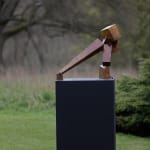Bruce Beasley American, b. 1939
Thrust, 1993
Bronze
48 x 41 x 33 cm
18 7/8 x 16 1/8 x 13 in
18 7/8 x 16 1/8 x 13 in
Edition 6 of 9
Copyright of Artist/ Pangolin London
Currency:
Further images
Bruce Beasley’s intersecting cuboid forms are reminiscent of natural crystalline structures, with sumptuous patinas adding to their organic essence. By breaking out of an expected pattern, his sculpture also has...
Bruce Beasley’s intersecting cuboid forms are reminiscent of natural crystalline structures, with sumptuous patinas adding to their organic essence. By breaking out of an expected pattern, his sculpture also has roots in early Modernism, which aimed to reassess the confines of the cube. Spaces are created that can be vigorously experienced, manipulating mass and volume in order to construct the impression of silence or movement.
Perhaps surprisingly, Beasley’s sculptures originate in digital three-dimensional design software, which allows him to devise his forms without the constraints of gravity; the shapes are later translated into solid bronze. Despite this highly technical process the natural world is remains Beasley’s inspiration explaining: Nature arrives at this perfect point between change and stillness, between form that is evolving and form that is complete; nature does this most easily and with rare mistakes.
Nature remains the ideal guide and the great resource; without it, there is no warmth, no heart and I insist that my work have both. Today, Beasley is recognized as one of the most noteworthy and innovative sculptors on the American West Coast. He discovered his natural affinity with metal at an early age and won a prize in a national metalworking contest aged 15. His first bronze casts were executed at Dartmouth College before he transferred to the University of California, Berkeley art department in 1959, a time at which Berkeley was seen to be the epicenter of a sculptural revival.
Beasley’s monumental work has been exhibited worldwide in solo and group exhibitions, receiving international acclaim. In 2005, his works were shown in a major retrospective at the Oakland Museum of California and in 2012, Pangolin London hosted the first major solo show in Europe by Beasley since his exhibition in 1995 at the Yorkshire Sculpture Park.
Perhaps surprisingly, Beasley’s sculptures originate in digital three-dimensional design software, which allows him to devise his forms without the constraints of gravity; the shapes are later translated into solid bronze. Despite this highly technical process the natural world is remains Beasley’s inspiration explaining: Nature arrives at this perfect point between change and stillness, between form that is evolving and form that is complete; nature does this most easily and with rare mistakes.
Nature remains the ideal guide and the great resource; without it, there is no warmth, no heart and I insist that my work have both. Today, Beasley is recognized as one of the most noteworthy and innovative sculptors on the American West Coast. He discovered his natural affinity with metal at an early age and won a prize in a national metalworking contest aged 15. His first bronze casts were executed at Dartmouth College before he transferred to the University of California, Berkeley art department in 1959, a time at which Berkeley was seen to be the epicenter of a sculptural revival.
Beasley’s monumental work has been exhibited worldwide in solo and group exhibitions, receiving international acclaim. In 2005, his works were shown in a major retrospective at the Oakland Museum of California and in 2012, Pangolin London hosted the first major solo show in Europe by Beasley since his exhibition in 1995 at the Yorkshire Sculpture Park.
Provenance
From the artist
Exhibitions
Bruce Beasley, 2012, PL; PL Sculpture Trail, Kings Place 2017/2018
Literature
Bruce Beasley, 2012, PL; Sculpture in the Garden, 2016
Publications
Bruce Beasley, 2012, PL; Sculpture in the Garden, 2016







